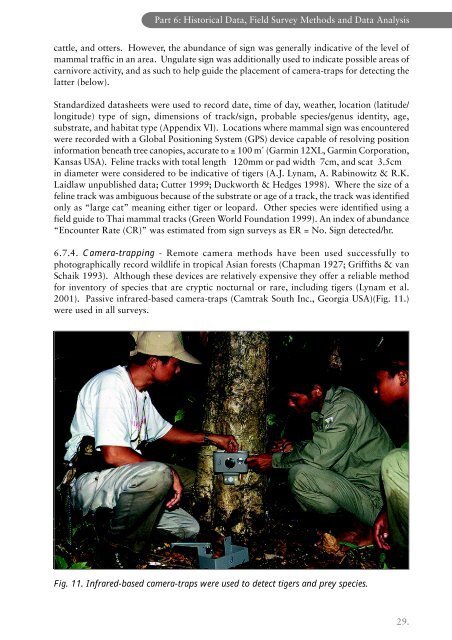Myanmar - Global Tiger Initiative
Myanmar - Global Tiger Initiative
Myanmar - Global Tiger Initiative
- No tags were found...
Create successful ePaper yourself
Turn your PDF publications into a flip-book with our unique Google optimized e-Paper software.
Part 6: Historical Data, Field Survey Methods and Data Analysiscattle, and otters. However, the abundance of sign was generally indicative of the level ofmammal traffic in an area. Ungulate sign was additionally used to indicate possible areas ofcarnivore activity, and as such to help guide the placement of camera-traps for detecting thelatter (below).Standardized datasheets were used to record date, time of day, weather, location (latitude/longitude) type of sign, dimensions of track/sign, probable species/genus identity, age,substrate, and habitat type (Appendix VI). Locations where mammal sign was encounteredwere recorded with a <strong>Global</strong> Positioning System (GPS) device capable of resolving positioninformation beneath tree canopies, accurate to ± 100 m * (Garmin 12XL, Garmin Corporation,Kansas USA). Feline tracks with total length 120mm or pad width 7cm, and scat 3.5cmin diameter were considered to be indicative of tigers (A.J. Lynam, A. Rabinowitz & R.K.Laidlaw unpublished data; Cutter 1999; Duckworth & Hedges 1998). Where the size of afeline track was ambiguous because of the substrate or age of a track, the track was identifiedonly as “large cat” meaning either tiger or leopard. Other species were identified using afield guide to Thai mammal tracks (Green World Foundation 1999). An index of abundance“Encounter Rate (CR)” was estimated from sign surveys as ER = No. Sign detected/hr.6.7.4. Camera-trapping - Remote camera methods have been used successfully tophotographically record wildlife in tropical Asian forests (Chapman 1927; Griffiths & vanSchaik 1993). Although these devices are relatively expensive they offer a reliable methodfor inventory of species that are cryptic nocturnal or rare, including tigers (Lynam et al.2001). Passive infrared-based camera-traps (Camtrak South Inc., Georgia USA)(Fig. 11.)were used in all surveys.Fig. 11. Infrared-based camera-traps were used to detect tigers and prey species.29.
















